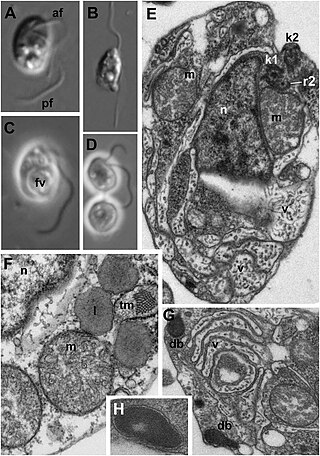
Monadofilosa is a grouping of Cercozoa. These organisms are single-celled amoeboid protists.

The raphidophytes, formally known as Raphidophycidae or Raphidophyceae, are a small group of eukaryotic algae that includes both marine and freshwater species. All raphidophytes are unicellular, with large cells, but no cell walls. Raphidophytes possess a pair of flagella, organised such that both originate from the same invagination. One flagellum points forwards, and is covered in hair-like mastigonemes, while the other points backwards across the cell surface, lying within a ventral groove. Raphidophytes contain numerous ellipsoid chloroplasts, which contain chlorophylls a, c1 and c2. They also make use of accessory pigments including β-carotene and diadinoxanthin. Unlike other heterokontophytes, raphidophytes do not possess the photoreceptive organelle typical of this group.

The ochrophytes are is a group of mostly photosynthetic stramenopiles (heterokonts), placed either in phylum Ochrophyta or subphylum Ochrophytina. Their plastid is of red algal origin.

Loukozoa is a proposed taxon used in some classifications of eukaryotes, consisting of the Metamonada and Malawimonadea. Ancyromonads are closely related to this group, as sister of the entire group, or as sister of the Metamonada. Amorphea may have emerged in this grouping, specifically as sister of the Malawimonads.
Phaeothamniophycidae is a subclass of heterokont algae. It contains two orders, Phaeothamniales and Pleurochloridellales, and consists of species separated from Chrysophyceae.

Bigyra is a phylum of microscopic eukaryotes that are found at the base of the Stramenopiles clade. It includes three well-known heterotrophic groups Bicosoecida, Opalinata and Labyrinthulomycetes, as well as several small clades initially discovered through environmental DNA samples: Nanomonadea, Placididea, Opalomonadea and Eogyrea. The classification of Bigyra has changed several times since its origin, and its monophyly remains unresolved.

Opalozoa is a subphylum of heterotrophic protists of the phylum Bigyra, and is the sister group to Sagenista. Opalozoans are non-photosynthetic heterokonts that are ancestrally phagotrophic but many times have evolved to be osmotrophic saprotrophs in the gut of vertebrate animals.

Dictyochophyceae sensu lato is a photosynthetic lineage of heterokont algae.

Halvaria is a taxonomic grouping of protists that includes Alveolata and Stramenopiles (Heterokonta).
Platysulcus is an eukaryotic microorganism that was recently discovered to be the earliest diverging lineage of the Heterokont phylogenetic tree. It is the only member of the family Platysulcidae, order Platysulcida and class Platysulcea, of uncertain taxonomic position within the phylum Bigyra. It contains the only species P. tardus.

Bigyromonadea is a recently described non-photosynthetic lineage of Heterokonts that at present contains only one species.
Pirsonia is a non photosynthetic genus of heterokonts. It comprises the entirety of the family Pirsoniaceae, order Pirsoniida and class Pirsonea in the subphylum Bigyromonada, phylum Gyrista.

Granofilosea is a class of cercozoan protists in the subphylum Reticulofilosa. Out of the three groups that were traditionally considered heliozoans: the heliomonads, gymnosphaerids and desmothoracids, the latter were recently grouped into this new class.

Raphidomonadea is a class of Stramenopiles containing both photosynthetic and phagotrophic protists. The phagotrophic groups are known as Raphopoda, and comprise actinophryid heliozoa and the marine genus Commation. The photosynthetic groups are known as the raphidophyte algae. Their relationship was elucidated through phylogenetic analyses.
The Scotokaryotes (Cavalier-Smith) is a proposed basal Neokaryote clade as sister of the Diaphoretickes. Basal Scotokaryote groupings are the Metamonads, the Malawimonas and the Podiata. In this phylogeny the Discoba are sometimes seen as paraphyletic and basal Eukaryotes.
Nanomonadea is a class of biciliate phagotrophic, non-photosynthetic free-living opalozoans, coontaining the sole order Uniciliatida. This monophyletic group previously known as clade MAST-3 is characterized by a single hairless posterior cilium and absence of an anterior cilium.

Gyrista is a phylum of heterokont protists containing three diverse groups: the mostly photosynthetic Ochrophyta, the parasitic Pseudofungi, and the recently described group of nanoflagellates known as Bigyromonada. Members of this phylum are characterized by the presence of a helix or a double helix/ring system in the ciliary transition region.
Commation is a genus of marine heterotrophic protists closely related to the actinophryids. It contains two species, Commation cryoporinum and Commation eposianum, discovered in antarctic waters and described in 1993. Currently, the genus is classified within a monotypic family Commatiidae and order Commatiida. Along with the photosynthetic raphidophytes, these organisms compose the class of stramenopiles known as Raphidomonadea.
Commation cryoporinum is a species of heterotrophic protists discovered in 1993 in Antarctic waters. It is one of two species in the Commatiida, an order of stramenopiles closely related to actinophryids, a group of heliozoan protists, and to raphidophytes, a group of algae.
Commation eposianum is a species of heterotrophic protists discovered in 1993 in Antarctic waters. It is one of two species in the Commatiida, an order of stramenopiles closely related to actinophryids, a group of heliozoan protists, and to raphidophytes, a group of algae.








